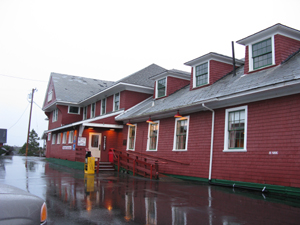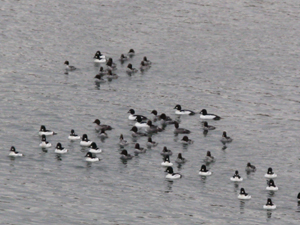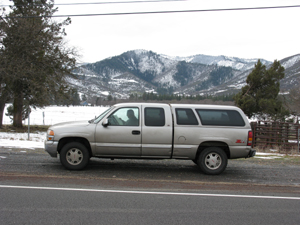 Coast redwood forest
the dire weather predictions -- snow and ice and bitter (for California) cold -- we determined
to drive from Alameda to Portland, Oregon, to make a second visit to Powell's City of Books.
Coast redwood forest
the dire weather predictions -- snow and ice and bitter (for California) cold -- we determined
to drive from Alameda to Portland, Oregon, to make a second visit to Powell's City of Books.
Our idea of a Christmas present to ourselves is to go on an adventure. This year, despite
 Coast redwood forest
the dire weather predictions -- snow and ice and bitter (for California) cold -- we determined
to drive from Alameda to Portland, Oregon, to make a second visit to Powell's City of Books.
Coast redwood forest
the dire weather predictions -- snow and ice and bitter (for California) cold -- we determined
to drive from Alameda to Portland, Oregon, to make a second visit to Powell's City of Books.
We have paid attention to Powell's for more than a decade: via the Internet, we sold them the bulk of Bob's math and computer books as we downsized ten years ago; we have found books in their catalogs when even Amazon came up blank; and when we made our first visit a few years back we loaded the truck with books we knew we wanted to read. Powell's is a complex of bookstores in Portland, with its largest store occupying an entire city block and open on Christmas Day. So it seemed a most appropriate destination.
 Samoa Cookhouse
We began by driving up the California coast, through vineyards and into forests where the
Coast redwoods flourish. Highway One is undergoing what seems like a permanent revision,
in which the old narrow twisty roads clinging to rocky hillsides are being straightened and
widened, making driving much easier but sacrificing some terrific scenery. We bypassed the
Lost Coast (now called King Range), a stretch of coastline deemed too treacherous for state or federal highway construction,
but spent some pleasant time enjoying redwood and Douglas fir trees, surrounded by lavish displays
of ferns.
Samoa Cookhouse
We began by driving up the California coast, through vineyards and into forests where the
Coast redwoods flourish. Highway One is undergoing what seems like a permanent revision,
in which the old narrow twisty roads clinging to rocky hillsides are being straightened and
widened, making driving much easier but sacrificing some terrific scenery. We bypassed the
Lost Coast (now called King Range), a stretch of coastline deemed too treacherous for state or federal highway construction,
but spent some pleasant time enjoying redwood and Douglas fir trees, surrounded by lavish displays
of ferns.
For breakfast the first morning, we visited the Samoa Cookhouse near Eureka, California. Remembering
 A Roosevelt elk
our first visit there, probably twenty years ago, we wondered whether the building would still be
there. It is, and it's unchanged. We were the only customers, but the waitress gave us a friendly
greeting and waved us to wherever we liked -- a stretch of long tables, just as lumbermen would have
found in their cookhouse a century or more ago. We were presented with bowls of potatoes, scrambled
eggs, sausages, biscuits, gravy and a plate of toast, along with pitchers of coffee and orange juice,
and were offered more when we showed signs of slowing down.
A Roosevelt elk
our first visit there, probably twenty years ago, we wondered whether the building would still be
there. It is, and it's unchanged. We were the only customers, but the waitress gave us a friendly
greeting and waved us to wherever we liked -- a stretch of long tables, just as lumbermen would have
found in their cookhouse a century or more ago. We were presented with bowls of potatoes, scrambled
eggs, sausages, biscuits, gravy and a plate of toast, along with pitchers of coffee and orange juice,
and were offered more when we showed signs of slowing down.
Well fed, we headed northward and soon found collections of Roosevelt elk grazing in meadows
along the highway. These elk occupy a relatively small territory in the Park, protected
 Myrtlewood bowl
from traffic by warning signs and frequent turnouts. The forests continued to be impressive, even
in the rain.
Myrtlewood bowl
from traffic by warning signs and frequent turnouts. The forests continued to be impressive, even
in the rain.
In southern Oregon, we stopped at a store selling myrtlewood objects. Myrtlewood, umbellularia californica, is also known as California bay or laurel, and is a fine hard wood popular with tourists. We had a nice conversation with the woodworker / shopkeeper, who urged us to turn inland in view of the worsening weather. He opined we might be unable to cross the mountains to Portland further north; the snow had melted to slush and then frozen back to ice. Winter had arrived earlier than usual in the Pacific Northwest. We took his recommendation.
On Christmas we reached our objective, after threading our way along partially slowplowed
roads, chunking over packed ice patches, avoiding cars sliding back and forth across the highway.
 Mount Shasta
This was on the interstate! But Powell's had indeed opened on Christmas
and we were not the first shoppers when we arrived in midmorning,
finding a precarious parking space for the truck atop a sloping mound of icy curbside snow.
We spent hours wandering the bookshelves, until we had amassed a totebag full of books.
Mount Shasta
This was on the interstate! But Powell's had indeed opened on Christmas
and we were not the first shoppers when we arrived in midmorning,
finding a precarious parking space for the truck atop a sloping mound of icy curbside snow.
We spent hours wandering the bookshelves, until we had amassed a totebag full of books.
Bob managed to rock the truck back and forth and out of the parking place without hitting other cars, and we attempted the always-difficult job of finding a restaurant open on Christmas. Off the freeway, the Portland city streets were even more treacherous, so we stopped at the first restaurant showing OPEN. It turned out to be a bar and lottery shop (the Oregon lottery uses slot machines for its players). The clientele, apart from us and the barmaid, was Vietnamese, all men smoking non-stop, even while eating. Nevertheless the food was some of the best Vietnamese food we've had, with pork and shrimp, noodles and fried rice and crisp vegetables.
 Sundial Bridge
On the road again after lunch, we headed east on the freeway and almost at once were hit with a thick
blizzard, with snowflakes as large as index cards -- or so it seemed. We stopped as soon as we found
a motel, and spent the afternoon and evening reading our books and playing with the computer.
Sundial Bridge
On the road again after lunch, we headed east on the freeway and almost at once were hit with a thick
blizzard, with snowflakes as large as index cards -- or so it seemed. We stopped as soon as we found
a motel, and spent the afternoon and evening reading our books and playing with the computer.
We learned that the next day would be free of precipitation, but after that a good-sized snowstorm promised to blanket the state for the rest of the year. So we decided we had had enough northern adventure and headed south. We made it all the way through Oregon, down the Willamette Valley and over the Siskiyous, stopping at the little hamlet of Weed, California. A surprise treat was the sight of Mount Shasta, partially covered by clouds.
As we returned to California, the weather continued to improve. In Redding we stopped to see the Sundial
Bridge, a footbridge connecting the city park and its Turtle Bay museum complex with a new botanical
garden and walking trail. The bridge was built in 2004 by Santiago Calatrava, an architect specializing
 Scoters in the river
in bridge design. As we walked along the bridge we watched waterbirds, including a flock of scoters,
as well as fishermen in the river below.
Scoters in the river
in bridge design. As we walked along the bridge we watched waterbirds, including a flock of scoters,
as well as fishermen in the river below.
As always on our trips, we avoid freeways whenever possible. As Interstate Five began to pick up traffic we found old highway 99, and other smaller roads, with almost-deserted towns scattered here and there. We began to see olive orchards. Some of these olive trees look very old, with thick trunks and branches which almost touch the ground. In some orchards, new trees are replacing some of the older ones. In addition to the olives, we saw fruit and nut trees, some already showing signs of spring leaves. As the valley widened, we passed truck gardens with cabbages, strawberries and other, less familiar plants, and we even saw a few orange trees. December is still a farming month in California's Central Valley!
In Colusa County we stopped for lunch at Granzella's in Williams. The establishment seems to take most of
downtown Williams, and includes a motel, a gift shop, a banquet center and the restaurant/deli, itself a city block.
 Christmas cacti, Capay Canyon
Half of the building is a store selling meats, cheeses and olives, with a large restaurant in the other
half. On this holiday Sunday, the restaurant had a waiting line; we eavesdropped on families and friends
gathering for lunch and learned that the restaurant had burned to the ground just a couple of years ago.
Now it has been rebuilt and enlarged and is a favorite of people throughout the region.
Christmas cacti, Capay Canyon
Half of the building is a store selling meats, cheeses and olives, with a large restaurant in the other
half. On this holiday Sunday, the restaurant had a waiting line; we eavesdropped on families and friends
gathering for lunch and learned that the restaurant had burned to the ground just a couple of years ago.
Now it has been rebuilt and enlarged and is a favorite of people throughout the region.
West out of Williams on Highway 20, we climbed Salt Canyon, then headed south of the Antelope Valley (not the one in the desert) to Cache Creek and the Capay Canyon, with farms and ranches of all sizes, from individual gardens to the occasional
small sheep ranch, and it looks as though some farmers have been here for many generations.
We enjoyed
the Christmas greeting on the prickly pear at the entrance to one farm. The big surprise (for us) toward the southern end of the road
 Our truck keeps going ...
was Cache Creek Casino, one of the burgeoning casinos built on Native American reservation land. It was
chock full of slot machines and had more active table games (including many varieties of blackjack and poker)
than any casino we had seen in Reno or Las Vegas. By early afternoon most of the slot machines were occupied, and a steady
stream of cars kept pouring into the Casino parking lot through the afternoon.
Our truck keeps going ...
was Cache Creek Casino, one of the burgeoning casinos built on Native American reservation land. It was
chock full of slot machines and had more active table games (including many varieties of blackjack and poker)
than any casino we had seen in Reno or Las Vegas. By early afternoon most of the slot machines were occupied, and a steady
stream of cars kept pouring into the Casino parking lot through the afternoon.
Last month, seduced by stories of low priced new cars and suspecting that the truck might soon need major maintenance, we made a little excursion into car-buying. However, even though we found several cars we might like, our truck has no apparent trade-in value. When we discovered this, we decided that we still love this vehicle which has been so faithful for over a decade, and have decided to keep it longer than its 246,000 miles. After driving it on this trip through snow, ice, rain and sleet, up mountain roads and along strange small side roads, we are happy we made that decision.